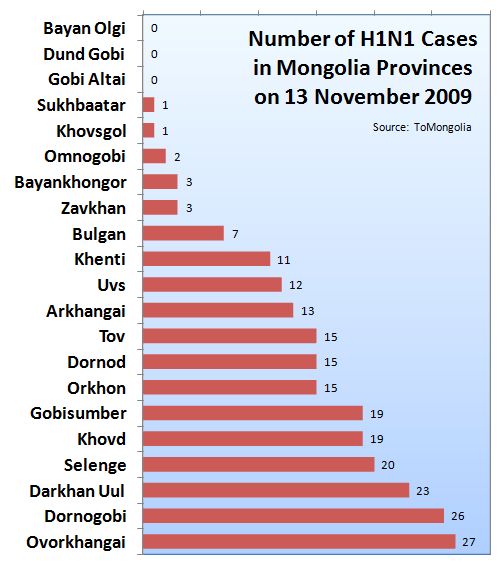See spreadsheets for updated detailed analysis and graphs of Mongolia H1N1 flu pandemic
Ulan Bator November 2009. Photo: Unuruu

The number of reported swine flu (H1N1 influenza) cases in Mongolia has reached 955 (as of November 12, 2009.) There are over 700 confirmed cases in the capital city Ulaanbaatar and over 200 confirmed cases throughout the country provinces. 12 deaths have been attributed to the H1N1 pandemic.
The Mongolian government is taking severe precautions to prevent further spread of the flu.
Following his statement, a state of emergency was declared. All public transportation out of Ulaanbaatar to the provinces was halted, affecting the routine daily travel of thousands.
 This precaution has slowed down the fast spread of the virus to the provinces.
This precaution has slowed down the fast spread of the virus to the provinces.Autumn school holiday has been extended; students will study at home via TV channels. Some markets have been closed. Public gathering has been banned.
The first case of H1N1 was reported on October 12th; within a month, over 900 cases were reported. Ulaanbaatar was the first places to be hit; the virus quickly spreading to the neighboring provinces.
The pandemic is not confined to Mongolia, it is a global pandemic with reported laboratory confirmed cases in 199 countries worldwide, including in the neighboring countries Russia and China.
The virus is a strain of the H1N1 virus that hit a third of the world population in 1918 with estimated 50-100 million dead.
Vaccines will be imported from Russia, China and from WHO (World Health Organization). A budget of MNT 753 million was allocated for purchasing medication.
The first batch of 45,000 vaccine doses is expected to arrive this week, from a total of 450,000.
The main manufacturer of H1N1 vaccine is the United Kingdom company GlaxoSmithKline (NYSE: GSK) It is the world's second largest pharmaceutical company. The company has announced it had production difficulties that limited the available supply of the vaccine. Shortages were reported globally.
The first round of vaccinations will be given to medical teams, emergency workers, border employees. The second round will include citizens at medical high risk, pregnant women, children and adults with chronic illnesses.
A total of MNT 6.4 billion was allocated from the CCF (Crisis Capital Fund) to purchase medicine, medical apparatuses, equipment for intensive care, disinfectants, ensure readiness of border checkpoints, grant the overtime payment and allowances to medical doctors and workers.
The autumn holiday started earlier, from 26 October rather than 4th November and continued until November 17th.
A team of about 100 teachers and experts was assigned to teach lessons via TV channels. Pupils of primary grades will learn Mongolian language and math; older children will study math, Mongolian language, chemistry, physics, biology, geography, history, English and Russian.
The Mongolian National Influenza center has published a set of personal precautions to prevent the spread of the H1N1 infection:
Early signs of influenza A(H1N1) are flu-like, including fever, cough, headache, muscle and joint pain, sore throat and runny nose, and sometimes vomiting or diarrhea.
The main route of transmission of the new influenza A(H1N1) virus seems to be similar to seasonal influenza, via droplets that are expelled by speaking, sneezing or coughing. You can prevent getting infected by avoiding close contact with people who show influenza-like symptoms (trying to maintain a distance of about 1 meter if possible) and taking the following measures:
• Avoid touching your mouth and nose;
• Clean hands thoroughly with soap and water, or cleanse them with an alcohol-based hand rub on a regular basis (especially if touching the mouth and nose, or surfaces that are potentially contaminated);
• Avoid close contact with people who might be ill;
• Reduce the time spent in crowded settings if possible;
• Improve airflow in your living space by opening windows;
• Practice good health habits including adequate sleep, eating nutritious food, and keeping physically active.
Update 13 November 2009
973 total number of H1N1 in Mongolia
741 total number of confirmed H1N1 cases in Ulaanbaatar
232 total number of confirmed H1N1 cases in the provinces
15 number of death attributed to H1N1
Copyright notice: The information on this page can be freely copied.
I would appreciate if you link back to this page.
ToMongolia@Gmail.com





2 comments:
the truth is that I believe that much of this disease has been psychological, because many more sick people are people who have complex health
Greeat post thank you
Post a Comment